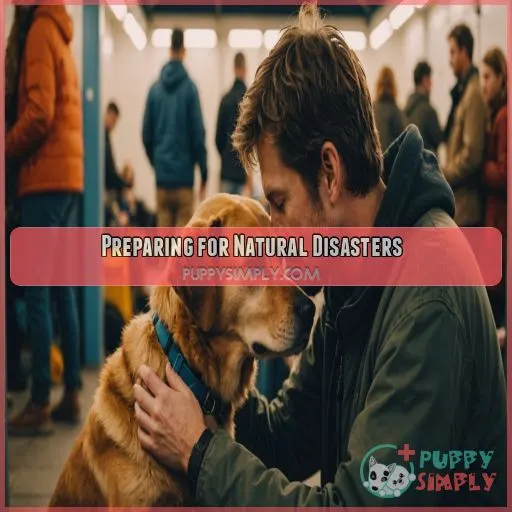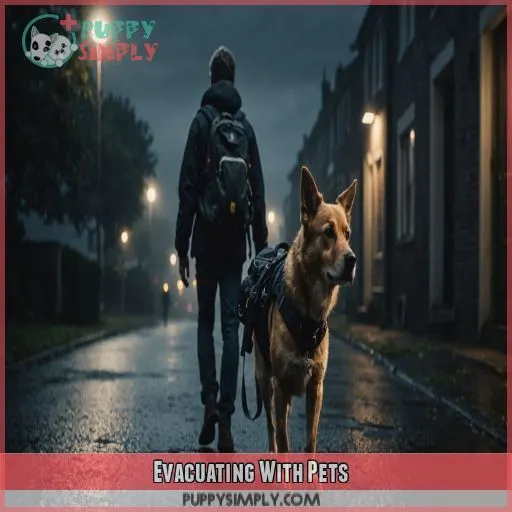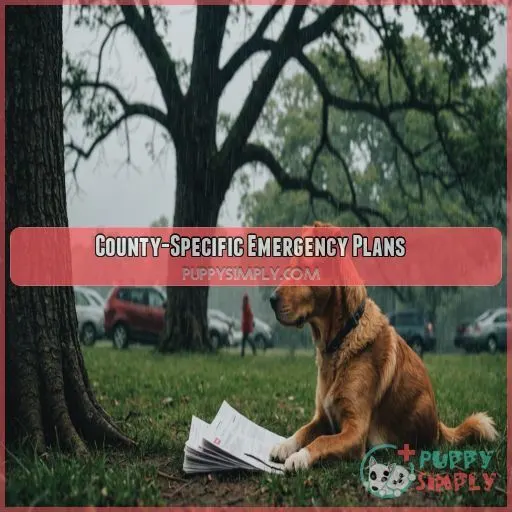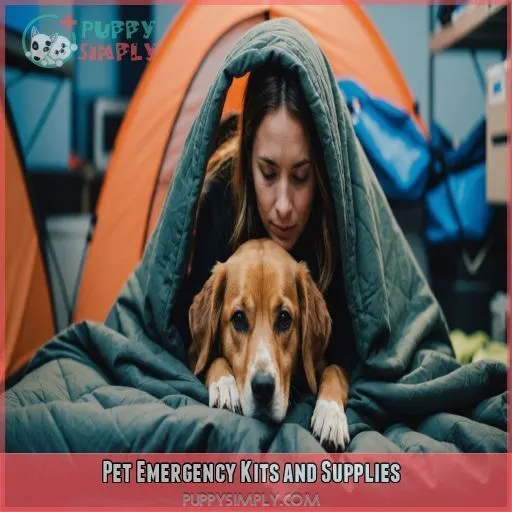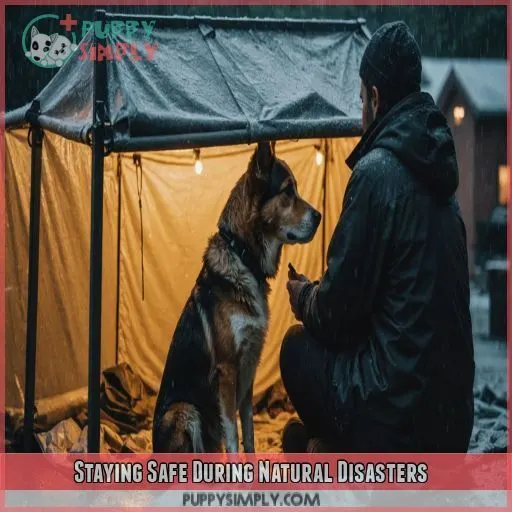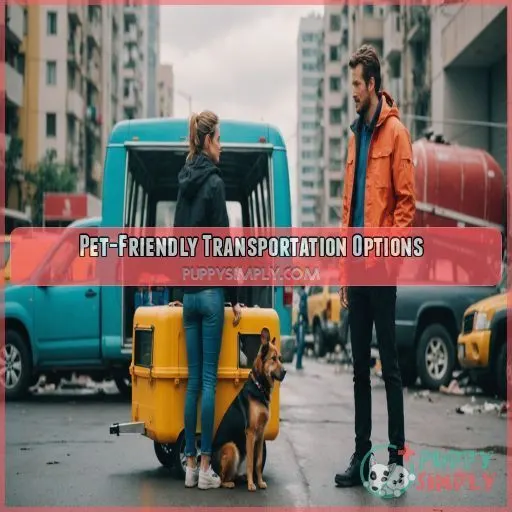This site is supported by our readers. We may earn a commission, at no cost to you, if you purchase through links.
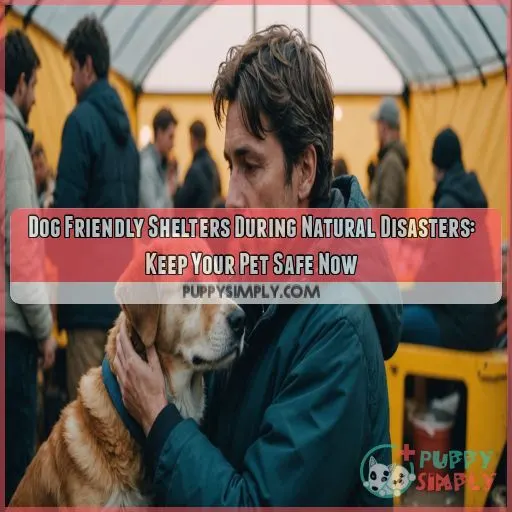
Finding dog-friendly shelters during natural disasters can be a challenge.
With some prep, you can keep your pet secure.
Research local pet-friendly evacuation shelters and hotels in advance.
Look for amenities like pet beds and walking areas.
Check with organizations like the Red Cross or local animal welfare groups for support.
Make sure to pack a pet emergency kit with essentials like food, water, and medication.
With a little planning, you can weather the storm with your loyal companion by your side.
Table Of Contents
- Key Takeaways
- Preparing for Natural Disasters
- Pet-Friendly Shelters and Hotels
- Evacuating With Pets
- County-Specific Emergency Plans
- Pet Emergency Kits and Supplies
- Staying Safe During Natural Disasters
- Pet-Friendly Transportation Options
- Reuniting With Your Pet After a Disaster
- Disaster Preparedness for Pet Owners
- Frequently Asked Questions (FAQs)
- What to do with pets during a natural disaster?
- How do dogs help in natural disasters?
- What is the Pets Act FEMA?
- How to evacuate a hurricane with pets?
- How do I calm my anxious dog during evacuation?
- Are there breed restrictions at pet-friendly disaster shelters?
- Can I bring exotic pets to emergency shelters?
- What if my pet needs special medical care?
- How long can pets typically stay at emergency shelters?
- Conclusion
Key Takeaways
- You’re not alone in this storm! Research pet-friendly shelters and hotels before disaster strikes. It’s like packing an umbrella before it rains – you’ll be glad you did when the clouds roll in.
- Pack a Pet Emergency Kit that would make MacGyver proud. Include food, water, medication, and your fur baby’s favorite toy. Trust us, a familiar squeaky duck can work wonders when things get rough.
- Keep your pet’s ID up to date and consider microchipping. It’s like giving them a tiny, high-tech breadcrumb trail back to you if you get separated in the chaos.
- Stay calm and carry on – your pet is picking up on your vibes. If you’re cool as a cucumber, your four-legged friend is more likely to keep their tail wagging, even in the eye of the storm.
Preparing for Natural Disasters
When natural disasters strike, you want to make sure you and your furry friend are prepared to stay safe together. By researching pet-friendly evacuation shelters, understanding the PETS Act and FEMA, and creating a pet emergency kit, you can take important steps to protect your pet and make sure they’re okay during a crisis.
Researching Pet-Friendly Evacuation Shelters
- Shelter Location and Contact Info: Make sure you know where the shelter is and how to get in touch with them.
- Shelter Amenities and Capacity: Find out what services the shelter offers, such as food, water, and medical care, and how many pets they can accommodate.
- Breed Restrictions and Requirements: Check if the shelter has any breed restrictions or specific requirements, such as vaccination records or microchipping.
Understanding the PETS Act and FEMA
You’ve found pet-friendly shelters, now it’s time to understand the PETS Act and FEMA‘s role in keeping your furry friend safe.
The PETS Act requires states to include companion animals in disaster plans to receive FEMA funding.
This means more pet shelters and resources for you.
Familiarize yourself with FEMA’s guidelines and local animal welfare organizations for a smoother evacuation process.
Creating a Pet Emergency Kit
When disaster strikes, you want to be ready to keep your furry friend safe. Create a pet emergency kit with essentials like:
- Food and water: a week’s supply of non-perishable food and a water filter or purification tablets.
- Medications and first aid: any prescription medications, a pet first aid kit, and a list of emergency contact numbers.
- Carrier and comfort items: a sturdy carrier or crate, a favorite toy or blanket, and a familiar scent like a pheromone spray.
Microchipping and Identifying Your Pet
Now that you’ve got your pet emergency kit ready, let’s talk about microchipping and identifying your pet.
Microchipping is a safe and permanent way to make sure your pet’s identification is clear.
It’s a one-time cost of around $50.
Make sure to register the microchip and keep the information up-to-date.
This, combined with a pet ID tag, increases the chances of a happy reunion if your pet gets lost.
Pet-Friendly Shelters and Hotels
When disaster strikes, you want to know your furry friend is safe, and that means finding a pet-friendly shelter or hotel ASAP. In this section, we’ll walk you through how to find the best options for you and your pet, from hotel chains with pet-friendly policies to evacuation shelters that’ll keep your pet safe and sound.
Finding Pet-Friendly Accommodations
When disaster strikes, you want to know your furry friend is safe. Finding pet-friendly accommodations is a top priority. Start by researching local pet-friendly shelters and hotels. Look for amenities like pet beds, bowls, and walking areas. Check online resources for booking tips and local regulations. Don’t wait until it’s too late – plan ahead for your pet’s safety.
- Book early: Pet-Friendly Hotels and shelters fill up fast, so book your spot as soon as possible.
- Check pet amenities: Make sure your chosen accommodation has everything your pet needs, from food to walking areas.
- Know local regulations: Familiarize yourself with local pet laws and regulations to avoid any last-minute surprises.
Pet-Friendly Hotel Chains and Policies
When searching for pet-friendly hotels, look for chains like La Quinta, Red Roof, and Motel 6, which often welcome furry friends. Check booking policies, pet fees, and cancellation policies before reserving a room. Some hotels offer pet-friendly amenities like dog beds and walking areas. Always prioritize your pet’s safety and comfort when choosing a hotel.
Pet-Friendly Evacuation Shelters and Requirements
When disaster strikes, you’ll want a safe haven for your furry friend. Research pet-friendly evacuation shelters in your area, noting their capacity, pet restrictions, and amenities. Some shelters require pre-registration, so don’t wait. Check if they receive FEMA funding, which means they can provide care for your pet. Keep their contact information handy for emergencies.
Evacuating With Pets
When disaster strikes, evacuating with your pet can be a real challenge, but with a solid plan, you can keep them safe and by your side. As you prepare to leave, you need to know how to pack the right supplies, secure your pet during transportation, and manage their stress – and yours – during this chaotic time.
Planning a Safe Evacuation Route
When evacuating with pets, plan a safe route in advance. Check for traffic, road closures, and alternate routes to avoid delays. Consider pet-friendly stops along the way. Here are some tips to keep in mind:
- Research pet-friendly shelters and hotels along your evacuation route
- Keep emergency supplies, like food and water, in your vehicle
- Stay informed about shelter updates and evacuation zones to make your trip smoother
Packing Essential Pet Supplies
Now that you’ve got a solid evacuation plan, it’s time to pack your pet’s essentials. Grab a carrier, food, water, medications, and a first-aid kit. Don’t forget your pet’s medical records, vaccination info, and any specific behavioral needs. If your pet has a favorite toy or blanket, toss that in too – it’ll help reduce stress during this chaotic time.
Securing Your Pet During Transportation
Now that you’ve packed essential pet supplies, it’s time to think about securing your pet during transportation. When evacuating with pets, safety is key.
- Use a sturdy, well-ventilated pet carrier to prevent escape or injury.
- Keep your pet on a short leash or in a carrier to prevent bolting.
- Monitor in-car temperature to prevent overheating.
- Plan for emergency stops and have a pet first-aid kit on hand.
Managing Pet Stress During Evacuation
As you evacuate with your pet, keep an eye out for anxiety signs like panting, pacing, or hiding. Bring familiar items like their favorite toy or blanket to provide comfort. Create a safe space in your vehicle or shelter with a familiar scent or pheromone spray. Use calming techniques like gentle petting or soothing music to reduce pet stress.
County-Specific Emergency Plans
When disaster strikes, you want to know that you and your pet have a safe place to go – and that’s where county-specific emergency plans come in. In this section, we’ll break down the pet-friendly emergency plans for counties in Florida, Georgia, North Carolina, and South Carolina, so you can prepare and keep your furry friend safe.
Florida County Emergency Plans
As you evacuate with your pet, familiarize yourself with Florida county emergency plans. Know the pet-friendly shelters, evacuation routes, and resources in your area. Check with your local government for specific requirements and emergency contacts. Stay prepared with a pet emergency kit and stay informed about hurricane preparedness and disaster preparedness to keep your furry friend safe.
Georgia County Emergency Plans
If you’re in Georgia, knowing the county-specific emergency plans can be a lifesaver for you and your pet. Research Georgia county shelters and pet evacuation routes in advance. Check the county’s website for disaster preparedness resources and shelter announcements. Some counties even have pet-friendly hotels and dog-friendly shelters, so it’s worth exploring those options too.
North Carolina County Emergency Plans
In North Carolina, it’s really important to know the county-specific emergency plans for pet-friendly shelters.
Research NC pet shelter capacity, evacuation routes, and disaster resources to make sure your furry friend is safe.
Familiarize yourself with NC pet laws and identify pet-friendly shelters in your area.
Stay informed, and you’ll be better equipped to handle natural disasters with your loyal companion by your side.
South Carolina County Emergency Plans
In South Carolina, each county has its own emergency plan, so it’s really important to research the specific plan for your area. Familiarize yourself with SC county resources, including pet-friendly shelters, evacuation routes, and emergency contact numbers. Knowing this information will help you and your furry friend stay safe during a natural disaster. Stay prepared, stay safe.
Pet Emergency Kits and Supplies
When disaster strikes, having a pet emergency kit ready can be a lifesaver – literally. By packing essential items like food, water, medications, and a carrier, you’ll be able to keep your furry friend safe and comfortable until the crisis passes.
Essential Items for Pet Emergency Kits
Now that you’ve got a handle on county-specific emergency plans, it’s time to prep your pet’s emergency kit. As a responsible pet owner, you want to make sure your furry friend is safe and comfortable during a natural disaster. Here are three essentials to include:
- A first-aid kit that fits your pet’s needs, with supplies like bandages and antiseptic wipes.
- A sturdy carrier or crate to keep your pet safe and secure during transport.
- A leash and collar with up-to-date identification tags, in case you get separated.
Food and Water Supplies for Pets
When packing food and water for your pet’s emergency kit, consider their specific needs. Store food in airtight containers and bring a manual can opener. Don’t forget travel bowls and a water source, like a portable water filter or purification tablets. Pack portion sizes for at least a week, and include emergency rations, like energy bars or canned food.
Pet Medications and First Aid Kits
Now that you’ve got food and water supplies covered, let’s talk about pet medications and first aid kits. Pack essential medications, such as prescription meds, flea and tick prevention, and heartworm medication. Don’t forget first aid basics like bandages, antiseptic wipes, and tweezers. Here are some must-haves:
- Prescription medications and copies of prescriptions
- Flea and tick prevention
- First aid manual and supplies (e.g., bandages, antiseptic wipes)
- Travel-sized essentials (e.g., tweezers, scissors)
Pet Carriers and Crates
When disaster strikes, a sturdy pet carrier or crate can be a lifesaver. Choose one that’s the right size for your furry friend, with enough room to stand, turn, and lie down. Consider types with ventilation, comfort pads, and secure latches. Make sure it’s travel-ready and can fit in your car or shelter, keeping your pet safe and cozy.
Staying Safe During Natural Disasters
When a natural disaster hits, your priority is to keep yourself and your pet safe. By staying informed, following evacuation instructions, and taking simple precautions, you can minimize risks and make sure your furry friend stays by your side throughout the ordeal.
Monitoring Weather Reports and Alerts
Stay one step ahead of severe weather with reliable weather apps and local alerts. Sign up for emergency notifications from your local government or weather radio to get timely updates. Remember Hurricane Irma and Hurricane Dorian – preparation is key. Know your pet-friendly shelters and have their contact information handy. Stay safe, and keep your furry friend safe too!
Following Evacuation Instructions
When evacuation orders are issued, grab your pet’s emergency kit and follow the recommended evacuation route to a pet-friendly shelter. Stay informed about shelter capacity, and have emergency contacts handy. Keep your phone charged and receive local alerts for updates. Prioritize pet safety, and remember, your calm demeanor will help your furry friend feel more secure.
Avoiding Hazards and Dangers
As you evacuate with your pet, watch out for hazards like poisonous plants, wildlife encounters, and road hazards. Keep your pet on a short leash and avoid areas with potential dangers. Research pet-friendly evacuation routes and shelters ahead of time to make sure you have a safe journey. Stay alert and aware of your surroundings to keep your pet safe.
Keeping Your Pet Safe During Disasters
When disaster strikes, your pet’s safety is top priority. Stay calm, grab their emergency kit, and head to a pet-friendly shelter or hotel. Keep them microchipped, tagged, and on a leash. Research evacuation routes and shelters beforehand. With pet safety training and disaster preparedness, you’ll be ready to protect your furry friend from harm.
Pet-Friendly Transportation Options
When disaster strikes, getting your pet to safety is a top priority, and that often means finding transportation that welcomes furry friends. In this section, you’ll learn about pet-friendly transportation options, including airlines, trains, rental cars, and cruise lines, to help you plan a safe and stress-free evacuation for both you and your pet.
Pet-Friendly Airlines and Policies
When flying with your pet, research airline pet fees, pet carrier requirements, and in-cabin pet limits. Make sure you have a pet health certificate and understand emotional support animal policies. Book a direct flight to minimize stress. Consider a pet-friendly airline like JetBlue or Southwest, which offer more relaxed pet policies. Always check with the airline for specific requirements.
Pet-Friendly Trains and Policies
Now that you’ve got the scoop on pet-friendly airlines, let’s talk trains! When traveling with your furry friend by train, research the train pet rules, costs, and size limits beforehand. Some trains have designated pet areas, so be sure to book accordingly. Follow train safety rules and keep your pet secure to make sure you both have a smooth ride.
Pet-Friendly Rental Cars and Policies
When renting a car with your pet, check the rental company’s pet policy beforehand. Some charge pet fees, have car size restrictions, or require pet carriers. Make sure your pet’s safety in the car by bringing a comfortable carrier and securing it properly. Consider travel insurance that covers pets, too, for added peace of mind.
Pet-Friendly Cruise Lines and Policies
If you’re planning a cruise with your furry friend, research pet-friendly cruise lines and their policies. Here are three things to keep in mind:
- Cruise Line Pet Restrictions: Check which breeds and sizes are allowed onboard.
- Pet Fees and Amenities: Know the costs and what’s included, like food and walking areas.
- Onboard Pet Care: Find out if veterinary care is available onboard.
Reuniting With Your Pet After a Disaster
You’ve made it through the disaster, but now you’re facing a new challenge: reuniting with your pet. Don’t worry, with the right planning and resources, you can be reunited with your furry friend and get back to normal life.
Microchip and Identification Recovery
Now that you’ve safely transported your pet, let’s make sure you can reunite with them quickly if you get separated.
Microchip your pet and register the chip with a national database.
Make sure identification tags are up-to-date and securely attached.
Familiarize yourself with scanner availability and pet recovery services.
This way, you’ll be prepared to find your furry friend quickly and efficiently.
Pet Rescue and Shelter Services
After a disaster, you’ll want to reunite with your pet ASAP. Pet rescue and shelter services can help. Look for shelters with enough capacity to take in pets, and consider volunteering or donating to support their efforts. Check with local animal welfare organizations for info on pet-friendly shelters and rescue services in your area.
Post-Disaster Pet Care and Support
After a disaster, your pet’s mental health is just as important as their physical well-being. Provide a familiar routine, plenty of love, and a nutritious diet to help them cope. Here are some essential post-disaster pet care tips:
- Reunite with care: When reuniting with your pet, do it in a safe and calm environment to avoid stressing them out.
- Check for injuries: Inspect your pet for injuries and provide immediate vet care if needed.
- Provide a safe space: Create a comfortable and quiet space for your pet to rest and relax.
- Seek shelter support: Reach out to local shelters or animal welfare organizations for food, supplies, and emotional support.
Disaster Preparedness for Pet Owners
You’re probably worried about keeping your furry friend safe during a natural disaster, and that’s totally understandable – after all, they’re part of the family. By taking some simple steps to prepare, you can make sure your pet’s safety and well-being are taken care of, even in the face of unexpected events like hurricanes, wildfires, or floods.
Creating a Pet Emergency Plan
Now that you know how to reunite with your pet after a disaster, it’s time to create a pet emergency plan. Start by identifying pet-friendly evacuation routes and shelters. Gather essential supplies like food, water, and a first-aid kit. Make sure your pet’s microchip and tags are up-to-date, and consider investing in pet insurance for added peace of mind.
Staying Informed About Natural Disasters
Now that you’ve created a pet emergency plan, you need to stay informed about natural disasters. Sign up for weather alerts and follow local news to stay ahead of the game. Know your evacuation routes, emergency contacts, and local resources, including dog-friendly shelters. Stay prepared, not scared!
- Imagine being separated from your pet during a disaster
- Picture your home destroyed, with no safe place for your pet
- Envision the stress of searching for a pet-friendly shelter
- Don’t let fear become a reality – stay informed and be prepared!
Preparing Your Home for Disasters
Get your home disaster-ready! Create a pet emergency kit with essentials like food, water, and medication. Make a home inventory, and identify safe zones for your pet. Post important phone numbers, like your vet and emergency contacts. Consider investing in a portable pet carrier and a pet-friendly shelter.
| Disaster Supplies | Emergency Contacts | Pet Safety |
|---|---|---|
| Food, water, medication | Vet, emergency services | Carrier, shelter info |
| Flashlights, batteries | Family, friends | Safe zones in home |
| First aid kit, blankets | Neighbors, pet sitters | Pet insurance info |
Staying Safe During Disasters
When disaster strikes, your pet’s safety is super important. Stay informed about evacuation routes, shelter options, and emergency plans. Have a pet carrier, food, and medications ready. Keep your pet microchipped and tagged. Consider dog-friendly shelters and follow instructions from authorities. Prioritize pet safety and stay calm – your furry friend is counting on you.
Pet-Friendly Hotels and Accommodations
When disaster strikes, you’ll want a safe haven for your furry friend. Look for pet-friendly hotels and accommodations that cater to your needs. Here are some essentials to keep in mind:
- Research hotel policies and pet-friendly amenities, such as dog beds and walking areas.
- Read reviews from fellow pet owners to make sure you have a smooth stay.
- Book in advance to secure a spot, especially during peak disaster seasons.
Pet Support and Care Services
When disaster strikes, you want your furry friend to be safe and cared for. That’s where pet support and care services come in. From pet insurance to boarding, grooming, and training, there are many resources available to help. Here are a few options to check out:
| Service | Description | Why It Matters |
|---|---|---|
| Pet Insurance | Covers unexpected vet bills | Gives you peace of mind |
| Pet Boarding | Safe and comfortable housing | Keeps your pet safe while you’re away |
| Pet Grooming | Keeps your pet clean and healthy | Boosts their mood and well-being |
Frequently Asked Questions (FAQs)
What to do with pets during a natural disaster?
During a natural disaster, don’t leave your furry friends behind! Pack their essentials, keep them close, and head to a pet-friendly shelter or hotel. Remember, your four-legged family members need your protection too. Stay safe together!
How do dogs help in natural disasters?
Dogs aren’t just our furry friends; they’re lifesavers in disasters! With their keen senses and training, they can sniff out survivors, offer emotional support, and even assist in search and rescue operations. They’re truly unsung heroes!
What is the Pets Act FEMA?
You might think FEMA’s only for humans, but they’ve got your furry friends covered too! The PETS Act guarantees your four-legged family members aren’t left behind in disasters. It’s like a safety net for all creatures, big and small.
How to evacuate a hurricane with pets?
Pack your pet’s essentials, secure a carrier, and plan your route to pet-friendly shelters or hotels. Don’t forget medications and ID tags. Stay calm – your furry friend’s counting on you. You’ve got this!
How do I calm my anxious dog during evacuation?
Like a ship in a storm, your dog needs an anchor. You’re it! Stay calm, use a soothing voice, and offer familiar toys. Keep them close, provide comfort breaks, and use calming pheromone sprays. Your steady presence is their safe harbor.
Are there breed restrictions at pet-friendly disaster shelters?
You’ll find that policies vary, but some shelters may have breed restrictions. It’s best to check ahead with local emergency services. Don’t worry, though – there’s always a solution for you and your furry friend!
Can I bring exotic pets to emergency shelters?
While Fluffy might be your best friend, exotic pets often can’t join the party at emergency shelters. You’ll need to find alternative arrangements for your scaly or feathered pals. Contact local wildlife centers for guidance.
What if my pet needs special medical care?
You’re not alone in this! Inform the shelter staff about your pet’s medical needs ASAP. They’ll often have vets on hand or can direct you to nearby clinics. Don’t forget to pack your furry friend’s meds!
How long can pets typically stay at emergency shelters?
You’d think pet-friendly shelters would roll out the red carpet indefinitely, right? Well, not quite. Typically, you’ll have 3-7 days of sanctuary. It’s best to have a backup plan for longer stays, just in case.
Conclusion
When Mother Nature decides to throw a curveball, being prepared can make all the difference for you and your furry sidekick.
By planning ahead, creating an emergency kit, and knowing your evacuation options, you’re not just protecting yourself, you’re safeguarding your loyal companion too.
Stay informed, stay ready, and keep those tails wagging, even in tough times.
With the right preparation, you and your four-legged friend can weather any storm together.

